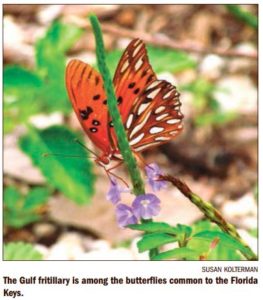Most of us have heard the saying, “Build it and they will come.” Can we apply this to attracting butterflies? If so, what are we building? The answer to the first question is definitely yes. The answer to what we are building is a little more complicated. Before you create a butterfly garden you must do a bit of research. First, you must determine which butterflies range within the area where you live. Then you must decide whether you want to create an oasis for butterflies to stop for nourishment, or if you wish to establish an ecosystem where they can set up housekeeping. Butterflies that range within an area may be permanent residents, or they may be seasonal or migratory.
 You can find out what butterflies are in your region from books on butterflies, websites such as regionalconservation.org and the University of Florida Extension Service. These resources will help you determine which butterflies you can attract and the plants necessary to do the attracting. Butterflies are attracted to plants for their nectar (nourishment) or to host their offspring by providing food for the larval stage of the butterfly. Often these two activities do not occur on the same plant. Butterflies will nectar on flowers from a wide variety of plants but tend to choose a specific plant for laying their eggs. Once the eggs hatch, the caterpillars will devour the leaves and often the flowers of these host plants; sometimes they even eat plant stems. The information you gather will help you determine whether you want to build an oasis or an ecosystem. If you choose to build an oasis, plant mostly nectar plants; for an ecosystem, you must plant both nectar and host plants. In either case, your choice of nectar plants should include those with as many different sizes, shapes, and colors of flowers as your planting area will accommodate.
You can find out what butterflies are in your region from books on butterflies, websites such as regionalconservation.org and the University of Florida Extension Service. These resources will help you determine which butterflies you can attract and the plants necessary to do the attracting. Butterflies are attracted to plants for their nectar (nourishment) or to host their offspring by providing food for the larval stage of the butterfly. Often these two activities do not occur on the same plant. Butterflies will nectar on flowers from a wide variety of plants but tend to choose a specific plant for laying their eggs. Once the eggs hatch, the caterpillars will devour the leaves and often the flowers of these host plants; sometimes they even eat plant stems. The information you gather will help you determine whether you want to build an oasis or an ecosystem. If you choose to build an oasis, plant mostly nectar plants; for an ecosystem, you must plant both nectar and host plants. In either case, your choice of nectar plants should include those with as many different sizes, shapes, and colors of flowers as your planting area will accommodate.
Since different-sized butterflies require different flower qualities to successfully nectar, planting the greatest variety will help attract the most butterflies that range within your area. If your ideal butterfly garden is an ecosystem, start with the nectar plants; then add host plants for the resident and migratory butterflies that you wish to have in your garden. It is often suggested that the host plants be planted among the nectar plants, but out of direct view, since some of them will become quite chewed up by caterpillars. The host plants can also be planted in a separate nearby area. If you want butterflies all year, the plants you choose for your butterfly garden should include annuals, perennials, shrubs and small trees that flower at different times throughout the year. This will ensure nectar is always available and butterflies will have a place to stop even when they are not breeding.
To see a locally planted butterfly garden, tour the new butterfly garden at John Pennekamp Coral Reef State Park. Plan a visit at floridastateparks.org and experience a butterfly garden in ‘the Real Florida.’
Susan Matthews is a volunteer with John Pennekamp Coral Reef State Park.
